The Ultimate 4 Days in Rome Itinerary
You’re about to spend 4 days in Rome? You’re one lucky fella! “The City of Seven Hills”, “An Earthly City”, the “Sacred City” of the world, no matter how it’s called, Rome is one of those special places everyone has on their bucket list. And trust me, there’s a good reason for that! However, because there’s so much to do there, planning a 4-day Rome itinerary can be overwhelming. I know it was for me before I went. I had a hard time trying to figure out how to fit everything into 4 days.
No matter what kind of traveler you’re, Rome got you covered. From Roman ruins to Renaissance art to charming streets, from pasta carbonara and maritozzi to Gelato and pizza al taglio, from Augustus to Theodosius there is so much stuff going on in the Italian capital that seeing it all in a single visit is plain impossible.
Spending 4 days in Rome, however, should give us just enough time to check out the biggest highlights and immerse into that world-famous spirit of the Roman Empire City.
I bet you have at least one friend who’s been to Rome and didn’t like it. This should not discourage you. Rome is not an easy city to explore. The must-see places are abundant, the public transportation system is cheap and efficient, but also confusing, and the city attracts huge tourist crowds! If you go there unprepared and spend most of your time waiting on a line or trying to figure out how to get from the Vatican City to the Roman Forum, chances are you won’t enjoy your vacation much.
Don’t worry, though.
Stumbling on this 4 Days in Rome guide means you are doing your homework properly and the chances are high you’re gonna enjoy the Eternal City to the max!
Enough hyping, let’s get started with this guide to the best things to do in Rome in 4 days!

4 Days in Rome: The Perfect 4 Day Rome Itinerary
With this itinerary, you will go through one of the top places in Rome, including:
Day 1: Pantheon, Trevi Fountain, and Spanish Steps, and a nearby neighborhood that is often overlooked.
2 Day: Colosseum, Palatine Hill, and Roman Forum on a self-guided walking tour of Rome’s city center.
Day 3: the Vatican and Castel Sant’Angelo, two of the most impressive historical sights in Rome.
4 Day: Altar of the Fatherland, Capitoline Museums, Jewish Ghetto, the Mouth of Truth, and the Pyramid of Caius Cestius.
If you prefer to soak in the sights instead of rushing from one tourist spot to the next, my 4-day Rome itinerary will help you discover the best of the best this city has to offer. However, I must say that the elevating atmosphere of Rome exists in between its landmarks – in the alleyways and piazzas that you’ll find around every corner.
How Many Days to Spend in Rome
That depends on your goal! With the right planning, 4 days in Rome can actually be enough for at least the major highlights and central neighborhoods such as Trastevere. I would not go for less than 4 days, otherwise, you’ll end up hopping from one attraction to another. If you want to really dive into the museums, explore more of the gardens, etc., you’ll want an extra day or two.
I was eager to take a second trip to Rome as soon as I was flying back to Dresden. So if you have more time to spare, go for it!
If you have extra time, a day trip outside Rome is something you should consider. You may want to visit the nearby Tivoli Gardens, the hilltop towns like Orvieto or Siena, or go on a Tuscan wine tasting tour.
If you plan ahead and hop on a fast train, you can even take a day trip to Florence! Pompeii is a popular–and worthy–day trip from Rome, but to accomplish it in just one day, you really need a tour. Pompeii is about 2 hours 15 minutes from Rome by train, longer (and more confusing) by bus, and trying to also squeeze in Vesuvius on an independent day trip from Rome would be nearly impossible.
I highly recommend going, it’s an incredible place–just be sure not to overstretch yourself! Within Rome itself, there’s also plenty to do with extra time: consider checking out the Palazzo Doria Pamphilj steps away from the famous Piazza Venezia, heading out to the 17th-century Capuchin Crypt, exploring Rome’s catacombs, visiting Domus Aurea, a former palace of Emperor Nero, taking a cooking class, or marvel at the interiors of Villa Farnesina.
Where to Stay for 4 days in Rome
In a nutshell, when it comes to the best places to stay in Rome, you’ve got plenty of options. If you’re a first-timer, the historic center is one of the city’s most beautiful districts that offers every type of shops, cafes, bars, and restaurants imaginable. Trastevere is another lively neighborhood just over the river from the historic center. The entire area is a picturesque warren of medieval streets and vibrant piazzas. In Trastevere, you’ll find a number of interesting sights, including some wonderful art-clad churches and villas.
However, the neighborhood’s biggest draw is the ample selection of bars and eateries, offering everything from Michelin-starred fine dining to authentic neighborhood pizzerias and hole-in-the-wall cafes. Great to explore by day, it has a variety of great places to go out at night where tourists and locals keep it lively until the early hours. Definitely, it’s not the quietest part of the city but there are some decent accommodation options.
Overall Best Hotel: Villa Agrippina Gran Meliá
Best Luxury Hotels in Rome
Hotel Hassler | The St. Regis Rome
Best Boutique Hotels in Rome
The Inn at the Roman Forum | Hotel Campo de’ Fiori | Portrait Suites | J.K. Place Roma
Best Mid-range Hotels in Rome
Internazionale Domus | Relais Le Clarisse
Best Cheap Hotels in Rome
Generator Rome | Funny Palace Hostel | Althea Inn Roof Terrace | Hotel Domus Tiberina
How To Get To Rome From Airport To Begin Your 4 Days In Rome Itinerary
It is actually very easy to get from Fiumicino Airport to Rome. There are, of course, various ways of getting from Fiumicino to Rome.
While Rome has two airports – Fiumicino Airport (FCO), and Ciampino Airport (CIA), the latter is much closer to Rome and the place where all the budget airlines fly. Fiumicino is the main airport where all international flights land.
Fiumicino is about 47 km from the city center, but it is significantly better connected. To reach Rome you can take shuttle buses, taxis, private transfers, buses or trains. There is no metro connecting the airport to the city center, but the high-speed Leonardo Express train takes you directly into the city center to Termini station.
Alternatively, there is also an FL1 regional train that runs between Fiumicino Airport and several points in central Rome. Keep in mind, it does not run to Termini station. Depending on where you stay in Rome you can disembark at Trastevere, Ostiense, Tuscolana, or Tiburtina stations in Rome. FL1 trains are way cheaper than the Leonardo Express trains.
Looking for a more luxurious way to travel?
It is very easy to take a taxi from the airport to take you to the hotel, just make sure the driver gives you a fixed fee. You can also arrange a private transfer from Fiumicino Airport to Rome. Here are some options:
Fiumicino Airport to Rome private transfer. A great option for small groups.
Fiumicino Airport to Rome private transfer in a luxury vehicle. If you like the idea of some extra comfort, you’ll love this option.
Shared shuttle from Fiumicino Airport to Rome. The best option if you need a vehicle more spacious than a car.
Fiumicino Airport to Rome shared luxury shuttle. Perfect for small groups who want to travel in style.
Getting Around Rome
The historic center of Rome is perfectly walkable. It is actually a bit more spread out in comparison with other European cities, but with its wide boulevards and narrow streets, there is nothing better than a leisurely stroll after eating a few slices of pizza.
With just three underground metro lines, the A Line (orange), the B Line (blue), and the C Line (green), the Rome metro system is one of the smallest in Europe. Since it doesn’t cover all neighborhoods of the city’s central nucleus, chances are high you’ll end up using all the transportation options available.
Visitors to Rome can get regular tickets and day passes at the station ticket machines and from corner stores and magazine kiosks. A standard one-way ticket (BIT) costs €1.50 euros. It is valid for 75 minutes for one metro ride or unlimited travel by bus or tram. You’ll need to validate your ticket before entering the train.
Read More: Top Beaches in Barcelona To Visit This Summer
The BIG day travel card (one-day pass) costs €6 euros. Note that it is valid from the moment the ticket is validated until midnight of the same day, not 24 hours after purchase. You need to validate the travel card only once as you enter the metro or the bus. If you fail to validate your ticket conductor will give you a hefty fine.
If you want to save time when getting around Rome, you might want to purchase a 72-hour transport pass. You’ll get the unlimited metro, bus, and tram travel within the city. Also, you may want to purchase the Omnia Vatican and Rome Card. Although not cheap, it includes:
- Priority entry to the Vatican Museums, the Sistine Chapel, two other attractions of your choice.
- Basilica and Cloister of Saint John in Lateran with audio-guide.
- Hop-on-hop-off bus tour.
- Unlimited access to the city’s public transport system.
- Basilica of St. Paul Outside the Walls and Cloister.
- Discounts to a number of sights, attractions, and museums in Rome.
Day 1: Pantheon, Trevi Fountain, and Spanish Steps
On your first day in Rome, this itinerary will take you through the heart of the Eternal city to explore some of the most famous places including the Pantheon, the Spanish Steps, and impressive churches! If you want to taste the real roman food, I would also highly recommend taking a cooking class one of the 4 days in Rome!
Pantheon
Located between Trevi Fountain and Piazza Navona, the Pantheon is one of the unmissable landmarks in Rome that boasts the world’s largest unreinforced concrete dome. Once a temple to the Roman gods, the Pantheon was turned into a church dedicated to Mary and the Martyrs in the early 7th century. Even after 2000 years, this edifice is the best-preserved Ancient Roman monument in Rome. The Pantheon is also notable for holding the tombs of a number of important folks, including Renaissance painter Raphael and King Victor Emmanuel II.
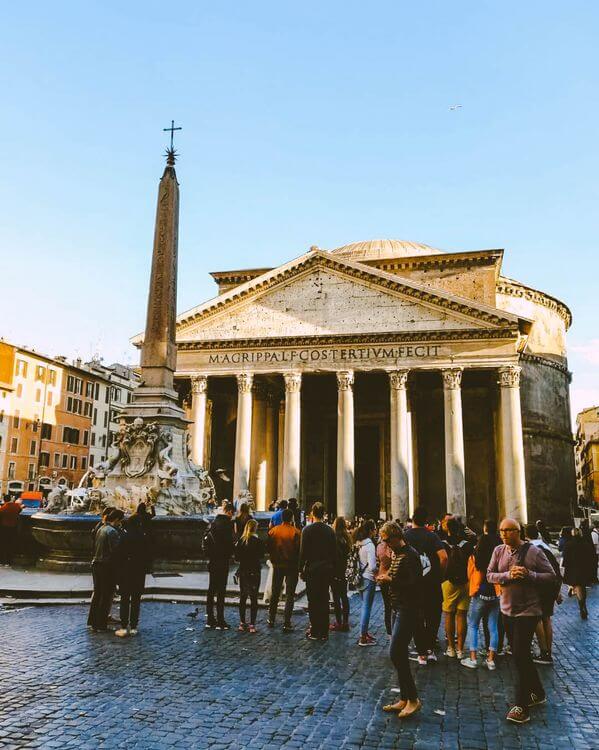
The Pantheon has no admission charge but you may want to opt for an audio guide to take you around (the tour lasts 35 minutes).
Address: Piazza della Rotonda, 00186 Roma RM, Italy
Church of St. Ignatius of Loyola
It’s no surprise visiting the Sistine Chapel is top of many people’s Rome wishlists, but only a few people know that the church of St. Ignatius of Loyola features an almost equally incredible ceiling art done by Andrea Pozzo. Inside you’d marvel at the beautiful dome not realizing that it is just a painting that makes it look like a real, three-dimensional one.
As a historian, I’m familiar with some of the spiritual teaching of St. Ignatius of Loyola, so this knowledge made my visit more meaningful. I was lucky enough to catch a children’s choir practicing in one of the side chapels, filling the church with that magical Christmas feeling. There is also no admission to the church, so drop by St. Ignatius of Loyola. It definitely worth your time while many tourists discover it by accident roaming the streets of Rome.
Address: Via del Caravita, 8a, 00186 Roma RM, Italy
Trevi Fountain (Fontana di Trevi)
Hardly in need of any introduction, the Trevi Fountain is one of the most popular tourist attractions in Rome. It’s on the list of any first-time Rome travelers. So you can expect large crowds of tourists at pretty much any time of the day or night.
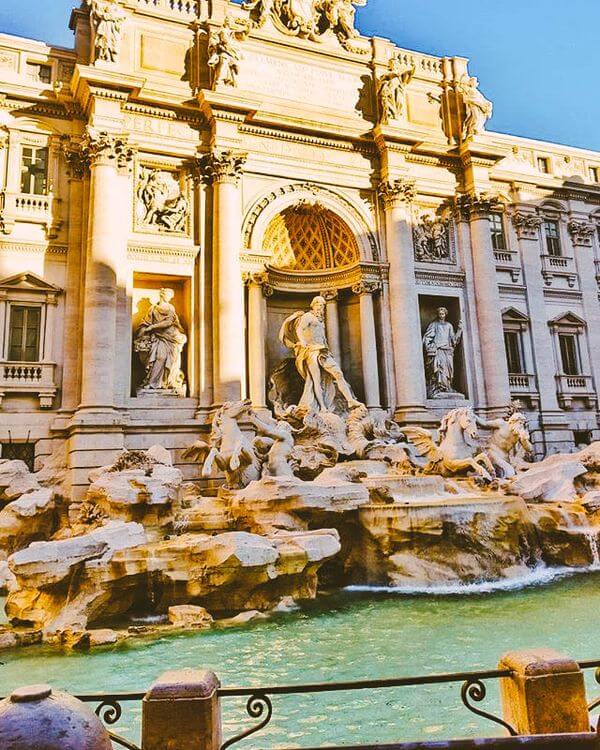
This world’s largest Baroque fountain was designed by the architect Nicola Salvi and commissioned by Pope Clement XII in 1732. Today, the legend has it that tossing a coin in to a fountain will ensure a return to the city. Some say that two coins will result in falling in love, while three coins guarantee that you get married. As a result, you can now observe the thousands of international coins glittering in the fountain. Interestingly, up to €3,000 euros thrown in to fountain daily by tourists and later used by a charity that helps those in need to purchase food.
Pro Tip: Crowds are usually thinner at night and early in the morning. Make sure to get there as early as possible if you don’t want to find thousands of folks tossing coins.
Address: Piazza di Trevi, 00187 Roma RM, Italy
Piazza di Spagna (The Spanish Steps)
Finish up the first day in Rome with a visit to the Spanish Steps. This staircase between the Piazza di Spagna (down) and Piazza Trinità dei Monti (up) — especially prominent among Europeans — was made famous worldwide by the 1953 film Roman Holiday. In the film, Audrey Hepburn’s character sat on the stairs and ate ice-cream. Many travelers have felt compelled to do so ever since. While you can’t sit on the steps now (it’s a law), you can go up the famous staircase to enjoy a beautiful view.
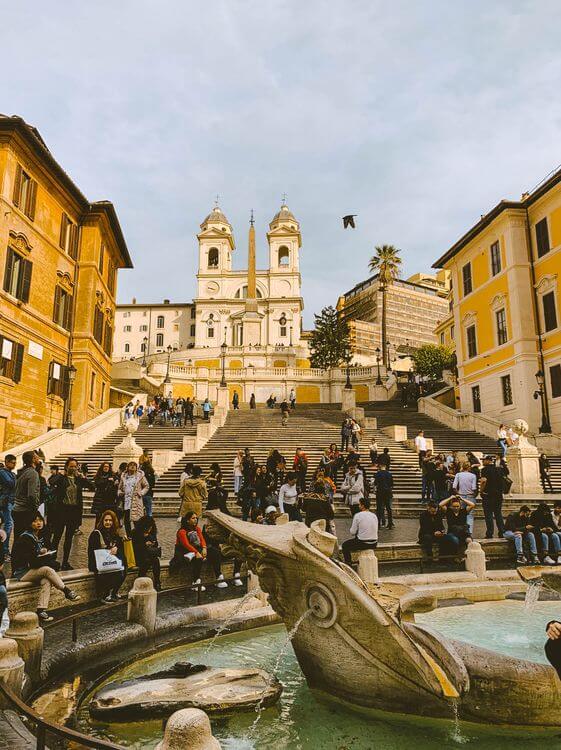
Named after the Spanish Embassy to the Holy See, on Piazza di Spagna, the 138-step stairway was built in the first part of the 18th century, connecting the Bourbon Spanish Embassy (hence the name) and the Trinità dei Monti church. This is definitely a highlight on any Rome itinerary where you can relax a little bit, eat Gelato, and watch the world go by. If you’re into shopping, the Spanish Steps face Via Condotti street, home to luxurious Italian and international fashion brands.
Address: Piazza di Spagna, 00187 Roma RM, Italy
Day 2: Colosseum, Palatine Hill, and Roman Forum
When it comes to sightseeing, I don’t take many tours, but for the below activities, it is definitely worth it just to skip the line to the most famous attractions in Rome (especially during the summer).
The Colosseum
Begin your second day in Rome with a visit to another Rome’s most iconic sight – the Colosseum.
Built in Roman times as one of the largest venues for public games and feasts, the Colosseum was also the primary location for the gladiatorial games, who would battle it out in front of audiences that could number as many as 80,000 people. If you either read or heard about the Roman gladiators, then one of the first things to do in Rome even if you stay only 4 days, is to visit Colosseum. I suggest doing this first thing in the morning. If you manage, get there early, even before it opens, to avoid wasting time in lines.
Some parts of this massive stone amphitheater are open to the general public. You can access them with a single ticket, while others can only be accessed with a guide or a tour. Keep in mind, that even if you have a pass with exclusive skip-the-line privileges, you will only be able to visit the Colosseum after you reserve your entry time to the Colosseum. During the high season, all the time slots do fill up.
If there are no timeslots available, but visiting the Colosseum is important to you, your best bet is to take a guided tour, as guided tours have a separate ticket allocation system. In this case, you don’t need to check timeslot availability for visiting the Colosseum. If you are interested in a tour, there are also the Colosseum night tours!
Take a look at these group tours that include skip-the-line tickets to the Colosseum:
Skip-the-Line Colosseum Small-Group Tour & Roman Forum
Colosseum Underground: Skip-the-Line Group Tour
Fast-Track Access Colosseum Arena & Underground Tour
Colosseum & Ancient Rome Family Tour for Kids
Guided Tour with Virtual Reality Experience
Colosseum, Palatine & Forum with Skip-The-Ticket-Line & Host
Address: Piazza del Colosseo, 1, 00184 Roma RM, Italy
Where to buy tickets: 00186 Rome, Metropolitan City of Rome, Italy
Palatine Hill
This 4-day Rome itinerary wouldn’t be complete without a trip to the Palatine Hill. Overlooking the Circus Maximus, and the Roman Forum sits this massive archaeological site, dotted with impressive ruins from the past.
Palatine Hill is steeped in history, as it once served as the home to majestic temples, rulers and aristocrats. It’s even surrounded by Rome’s most important myth – the legend of Romulus and Remus, making it a notable part of the local history. And, aside from its historical roots, the entire area is a green retreat for nature lovers who want to break away from city life. You can pack your own cheese, crackers or panini, and enjoy your lunch sitting under the shady trees that surround the on-site garden.
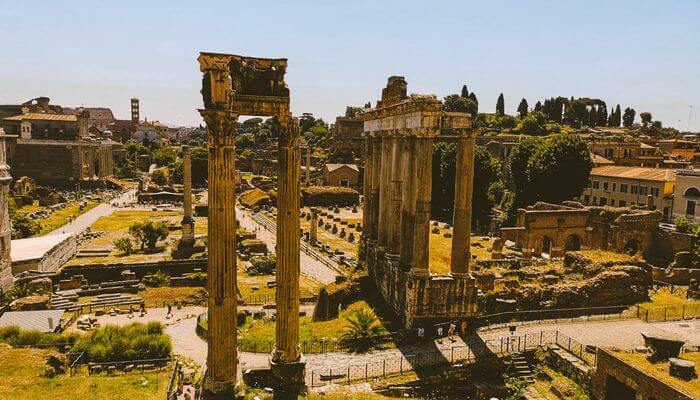
While taking a break from sightseeing among the wildflowers, you will have sweeping views of the ruins and the modern city. Palatine Hill looks out over the Aventine Hill, and the Capitoline Hill, offering postcard-worthy views. Your Forum/Colosseum ticket also covers the Roman Forum and Palatine Hill (if you visit both sites on the same day), which is conveniently located right next door.
Roman Forum (Foro Romano)
Like most ancient buildings around it, the Roman Forum is filled with a sense of history. In ancient times it was the heart of Roman social, political, and religious life. Although the surviving remains give only a hint of the grandeur and splendor of this place the Roman Forum doesn’t fail to inspire and amaze 21st-century visitors.
A remarkable, although a slightly chaotic cluster of ruins, the Roman Forum, was also an impressive site of temples, monuments, elections, processions, criminal trials, and gladiator matches. Today, it showcases the Roman architectural achievements because, by the end of the Imperial Period, the Forum was a densely built-up area where more “modern” buildings often built over older ones.
The Roman Forum was one of my favorite places to explore because you were able to see the Temple of Saturn, the Arch of Titus, and the Curia (Senate House) up close and personal. You have the opportunity to walk through what once was a thriving market place, where the Senate used to meet to discuss administrative matters and take decisions about the Roman government. If you go to see the Colosseum at night, when you walk past the Roman Forum, you will see they put spotlights all over which is eye-appealing! Overall, the Roman Forum is one of the highlights on any 4-day Rome itinerary.
Address: Via della Salara Vecchia, 5/6, 00186 Roma RM, Italy
Take a look at some of the best guided tours that combine a visit of the Colosseum and the Roman Forum:
Colosseum Underground, Arena, Roman Forum & Hill Tour
Rome: 3-Hour Bike Tour
Colosseum, Roman Forum, Palatine Hill Fast-Track Tour
Skip The Line Colosseum and Forum Walking Tour
Colosseum, Roman Forum & Palatine Hill Priority Access Guide
Day 3: Vatican and Castel Sant’Angelo
On day 3 get up early and head for the Vatican Museums. I suggest tackling St. Peter’s Basilica and the Sistine Chapel first because they are huge and with so much to see. To save some time and avoid the lines you may opt for a tour that included a guided tour of the museums, Sistine Chapel, and entrance to Saint Peter’s Basilica. While I don’t think you need someone to explain the wonders of this place, skipping the line is worth it! Take a look at this Vatican Skip the line tour!
The Vatican City
When visiting the Eternal City, you are obviously going to visit the Vatican because it’s always at the top of the list of must-see attractions in Rome.
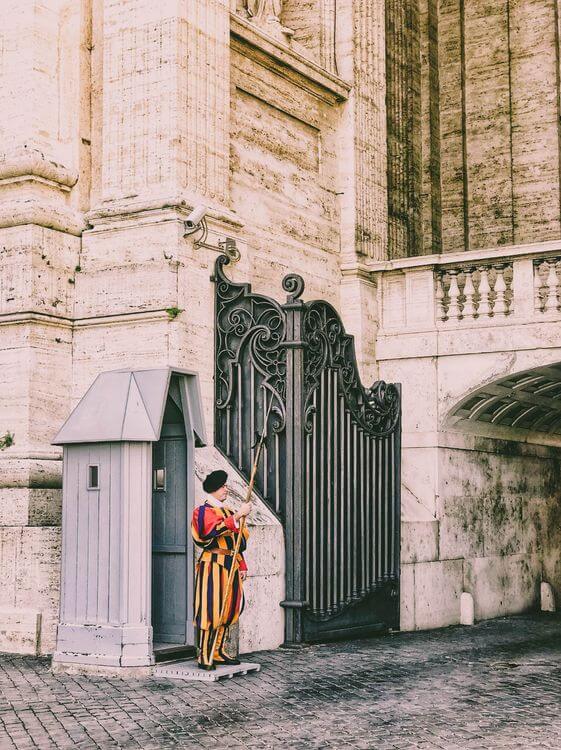
Since the Vatican is a country of its own with so many incredible sights, do your best to come as early as 9:00 AM, when Vatican Museums and Sistine Chapel officially open to the public. If you don’t have a skip-the-line ticket, you should know that lines to get into the Vatican Museums start forming as early as 7:30 AM. With an Omnia Rome and Vatican pass, you get the option to pre-book a timeslot for your skip-the-line entry.
Alternatively, you can also book tickets online directly from the Vatican.
Read Next: 33 Proven Tips to Save Money While Traveling in Europe
There is so much to see in the Vatican Museums, which span 7km of exhibitions, so you could spend an entire day here. My favorites include the Galleria Delle Carte Geografiche, the Sistine Chapel, and the fabulous Raphael Rooms, but I’m sure you’ll discover treasures of your own.
Next, it’s time to pay St. Peter’s Basilica a visit. Located within the Vatican City, this perfectly built Late Renaissance Church boasts spectacular interior decor and impressive infrastructure. It can hold up to 60,000 people. The basilica is regarded as one of the holiest Catholic shrines.
Peter, one of the chosen 12 apostles of Jesus and, according to tradition, first Bishop of Rome.
Inside the basilica, you’ll find magnificent masterpieces of Bernini, Michelangelo, and Bramante over a site considered to be the tomb of St. Peter. Marble-encrusted interior contains 11 side chapels, 45 altars, and an incredible number of mosaics. If you’re up to it, I recommend the climb to the top of St Peter’s Basilica dome. St Peters dome cupola offers sweeping views over the city, as well as the chance to see the Basilica from above.
Again, make sure to have a ticket that lets you skip the line, which during the peak season can stretch right around the square.
Once you’re done with the priceless treasures of the Vatican City, it’s time to head on to the next stop. Don’t feel you need to rush though – the Vatican City is definitely worth your time, and you are welcome to spend a few hours exploring at your own pace. Other attractions will wait. When you’re ready, a short walk will take you to the next stop on this list.
Address: Viale Vaticano, 00165 Roma RM, Italy
Take a look at tours of the Vatican with early access and entrance to St. Peter’s Basilica:
Vatican Early Entrance Skip-the-Line Small Group Tour
Early Entry to the Vatican & The Sistine Chapel
3-Hour Semi-Private Early Vatican Tour
Castel Sant’Angelo (Hadrian Mausoleum)
Originally built as a mausoleum for Emperor Hadrian between 134 and 139 A.D., the Castel Sant’Angelo is now a national museum. It has also been a medieval stronghold, pope’s residence, and a political prison. It’s connected to the Vatican through the so-called Passetto di Borgo, an 800-meter fortified corridor built to protect the Vatican from the foreign invasions and allow the Pope to seek shelter in Castel Sant’Angelo. Overall, Castel Sant’Angelo is an interesting historical site to explore.
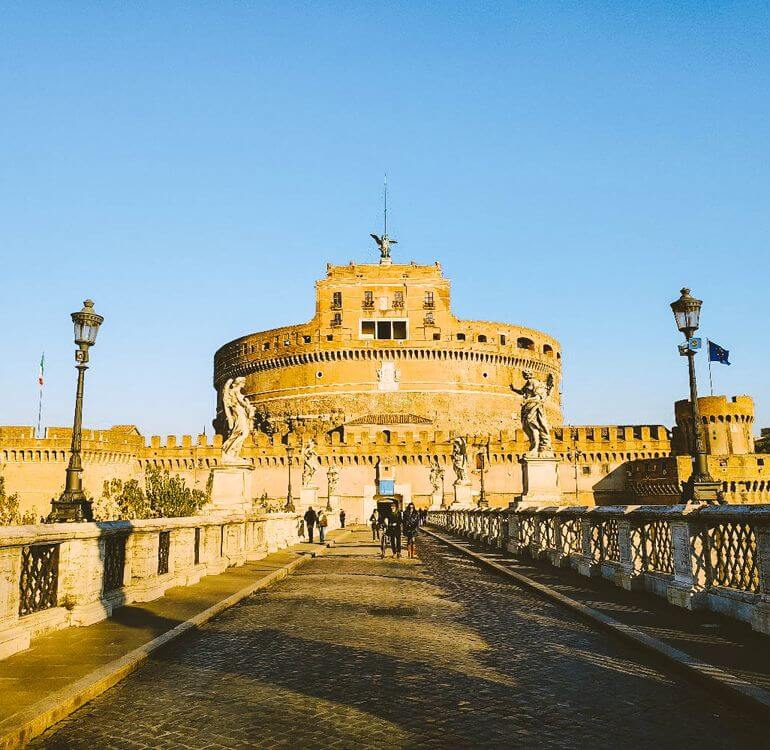
If you have 4 days in Rome you can visit this cylindrical building to appreciate the Room of the Urns and the Courtyard of the Angel. The latter is most notable for the marble sculpture of the angel that once sat at the top of Castel Sant’Angelo. Legend holds that when the plague had hit Rome, Pope Gregory had a vision of Archangel Michael sheathing his sword upon the summit and signaling the end of the plague. Hence the name.
Address: Lungotevere Castello, 50, 00193 Roma RM, Italy
For tickets and tours of Castel Sant’Angelo, consider the following options:
Castel Sant’Angelo Tour with Fast-Track Access
Tour of Castel Sant’Angelo With Skip-the-line Access
Castel Sant’Angelo Skip the Line Small-Group Tour
The Tomb of Hadrian Guided Small Group
Now, time to get some sleep before day four of our 4-day Rome itinerary!
Day 4: The Rest of Rome
The last day of your 4 days in Rome itinerary is all about places that aren’t as famous as the Vatican City, but just as interesting! Start with Piazza Navona, which is close to the Pantheon and then move to the Altar of the Fatherland and Trajan Forum. You can even head directly to the Mouth of Truth, a marble mask, which stands against the left wall of the portico of the Santa Maria in Cosmedin church. Finally, you may want to pay the Jewish Ghetto a visit. This is a neighborhood full of charming streets, history, and ancient Roman ruins.
Piazza Navona
Often regarded as one of the most beautiful and popular squares in Rome, Piazza Navona dates back to the 1st Century. The square is full of gorgeous Baroque architecture but undoubtedly Bernini’s Fountain of the Four Rivers makes the entire place so special. Another main point of interest is the stunning church of Sant’Agnese in Agone. It was built between 1652 and 1672 with broad horizontals and the cupola rising immediately behind the façade.
Depending on the time of day and week that you visit, the square often features street performers and markets.
You can also find a lot of restaurants and cafes around the square in case you want to grab a bite. Although bear in mind that you always pay more at the more popular locations, especially if they have outdoor seating.
Altar of the Fatherland
The Altare Della Patria is also known as the Altar of the Fatherland, or Vittoriano. This is a giant monument honoring Victor Emmanuel II, the king who united divided Italy in 19 century. Located on the Capitoline Hill, Vittoriano is one of the most remarkable buildings in the city.
The Neoclassical Altar of the Fatherland was designed by Giuseppe Sacconi who built it around huge stairways and tall Corinthian columns.
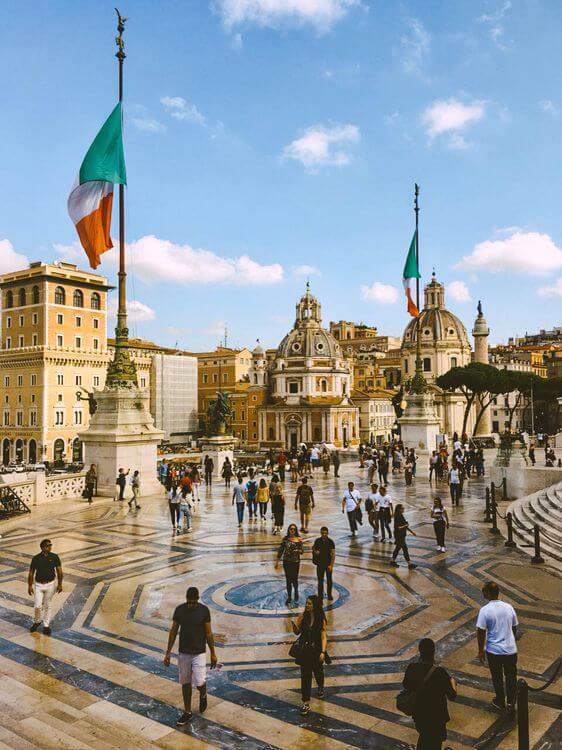
Throughout the monument itself, you can see statues, sculptures, as well as a number of impressive relief statues that were made by eminent Italian sculptors from all over Italy. The main centerpiece of the Vittoriano is the large equestrian statue of Victor Emmanuel II. Due to the shape of the monument, it has been given several nicknames such as The Wedding Cake, the False Teeth, and The Typewriter.
There is also a museum in the base of the monument. This museum is dedicated to the unification of Italy and if you’re into history, it is well worth a visit.
A visit to Vittoriano would not be complete without taking the glass elevator to the roof terrace. At €7 per person, it may seem a bit pricey. However, it is easily worth it for the panoramic views it offers of the city such as the Forum and even St. Peter’s Basilica in the distance. Consider going in the evening when you can enjoy the sunset over the Roman skyline.
Address: Piazza Venezia, 00186 Roma RM, Italy
Trajan Forum
As you walk along Via Dei Fori Imperiali (the street of the Imperial Forums), you might have been intrigued by the number of archaeological ruins on either side of the street. According to its name, the entire area holds many imperial forums built by different Roman emperors. The forums formed the key political, ritual, and civic center of Ancient Rome. If you are walking from Piazza Venezia towards the Colosseum, on your left you’ll see the forum commissioned by the emperor Trajan and designed by Apollodorus of Damascus.
This Forum was actually the last one to be constructed in the Roman Empire. It was inaugurated between 112 and 113 AD after the conquest of Dacia (modern Romania), which was Trajan’s biggest military achievement. Once completed, the Forum consisted of a large square lined with arcades. It also held the Basilica Ulpia, two libraries, the markets, and a temple. Today, only a small section of the forum remains. As well as part of the markets, and the imposing Trajan’s column.
Address: Via dei Fori Imperiali, 00186 Roma RM, Italy
Largo di Torre Argentina
Aside from being a convenient central bus hub to get around Rome, Largo di Torre Argentina (commonly referred to as Largo Argentina) is a central square filled with a bunch of walled-off Roman ruins. Exploring the area you can see the remains of four Roman temples that were unearthed in the 1920s during building construction work. These strikingly important ruins that mistakenly thought to be the place where Julius Cesar met his end are easy to miss on a busy 4-day Rome itinerary since there are no markers drawing attention to it.
In recent decades Largo Argentina has become popular for the many stray and lovely photogenic cats that sleep undisturbed on top of columns and bask in the sun. If you’re a cat person, visit the oldest cat sanctuary in Rome where you can make a donation, help animals in need by purchasing a souvenir (ie a Cats of Rome calendar) and play with our feline friends a bit.
Address: Largo di Torre Argentina, 00186 Roma RM, Italy
Jewish Ghetto
One of Europe’s oldest Jewish Quarters (only Venice one is older), this charming quaint neighborhood was established in 1555 in the Rione Sant’Angelo, near the Tiber River. Hidden in the heart of the city, the Jewish Ghetto was once the place where all Jews were forced to move in. It was surrounded by walls that kept it separated from the rest of the city.
Today, this is one of the coolest neighborhoods in Rome with restaurants, churches, and synagogues. It combines Jewish culture with the grandeur of Roman architecture. The ruins of the enormous Portico d’Ottavia, Marcello Theater (by Julius Caesar), and Temple of Apollo Medicus Sosianus are a testament to history as well as the changes time brings.
To make the most out of your visit, make sure you visit the Great Synagogue and the Jewish Museum. Both buildings tell the history of the local Jewish community and display silverware and textiles, parchments, and marble carvings.
The Mouth of Truth (Bocca della Verità)
End your fourth day in Rome with a visit to the Mouth of Truth. If you’ve seen the movie Roman Holiday (1953) with Audrey Hepburn, you’ll remember that Gregory Peck and Audrey Hepburn pop their hands into the mouth of this massive marble mask, which is said to bite off the hands of liars.
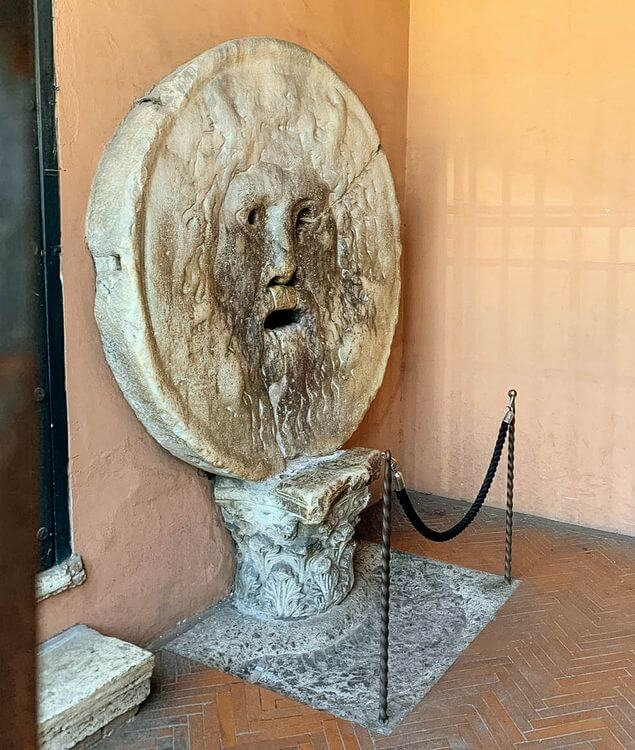
Although it’s not clear when exactly this legend originated, the good news is that you too can visit the Mouth of Truth, or Bocca del Verita, and pop your own hand in for a photo opportunity.
You’ll find it outside the entrance to the Santa Maria in Cosmedin church, which is close to the Baths of Caracalla and the Colosseum. It can get busy here in the summer months. But the line is kept moving fairly quickly, so you won’t have to wait too long.
Address: Piazza della Bocca della Verità, 18, 00186 Roma RM, Italy
Quick Tips For Your 4 Days In Rome Itinerary
Here are some quick tips and tricks, which will make your 4 Days in Rome more enjoyable.
Remember, always stay hydrated! Bring a reusable water bottle and refill it for free at the public water fountains. You will be taking care of your health, and saving the environment from the devastating effects of plastic pollution.
Do not worry about the language barrier. I know only a very few basic Italian words and had absolutely no difficulties when I visited Rome. In tourist cities, hotel staff usually speak fine English so you’ll be able to communicate enough to make your wishes known. In less popular areas you may want to use a translator app on your phone to assist with your communications.
Read Next: 15 Best Day Trips From London You Shouldn’t Miss
Call your credit card company and verify if they charge a foreign transaction fee. If they do, inquire about applying for a credit card that does not charge you a fee every time you use it abroad.
When you visit an ATM in Rome, make sure it is in the same network with your bank. In this case, they won’t charge you transaction fees every time you withdraw cash. Because these small charges can add up quickly, consider withdrawing larger amounts of cash than you might normally do at home.
Purchase advance tickets to attractions whenever possible. First off, many popular sights sell advance tickets that guarantee admission at a certain time. Take advantage of them to avoid lines. Secondly, when you buy tickets for the monuments and museums suggested in the 4 days in Rome itinerary, you will have a schedule planned out and know exactly what your plans are for every day of your trip.
Four days in Rome is a long enough time to get to know the Eternal City and marvel at all it has to offer: rich history, monuments and museums, street markets, and pizzerias. Your ultimate 4 days in Rome itinerary has mapped out for you some of the best Rome tours and highlights.
Have you ever been to Rome? What were your favorite things to do in Rome? What would be your top recommendation for a first-time visitor? Leave me a comment below, I’d love to hear from you.
Love “How to Spend 4 Days in Rome”? Pin it for later!
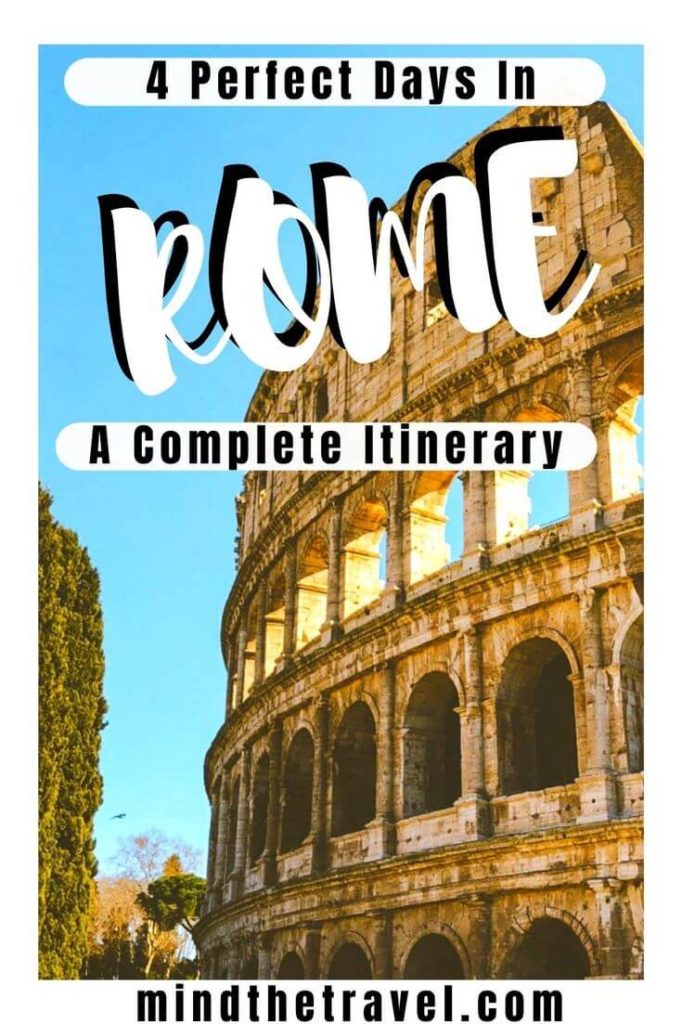
Found my blog useful?
I do my absolute best to make MindTheTravel as good as it can be. If you’ve found it useful and would like to help keep it running, you can Buy Me a Coffee!
Just click the button below, or at the bottom of any page and treat me to a coffee! Thank you for your support.





Sorry, the comment form is closed at this time.